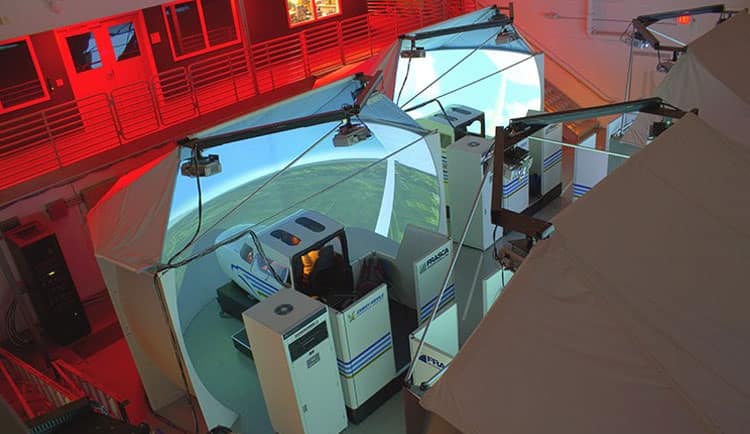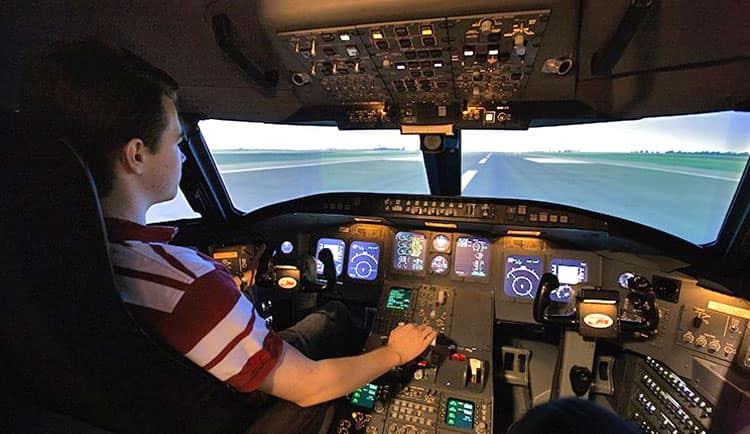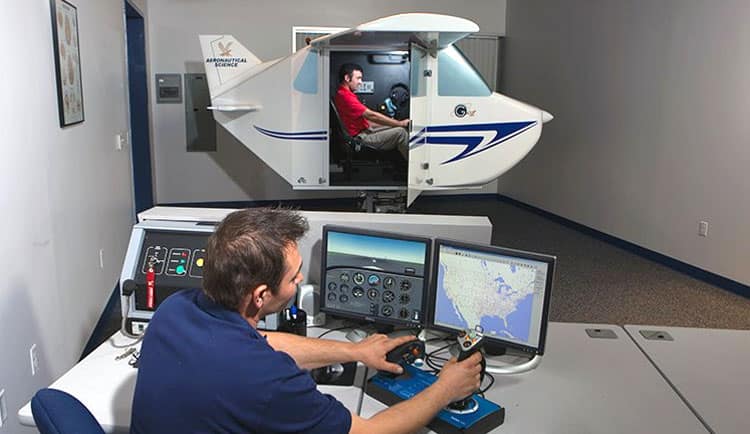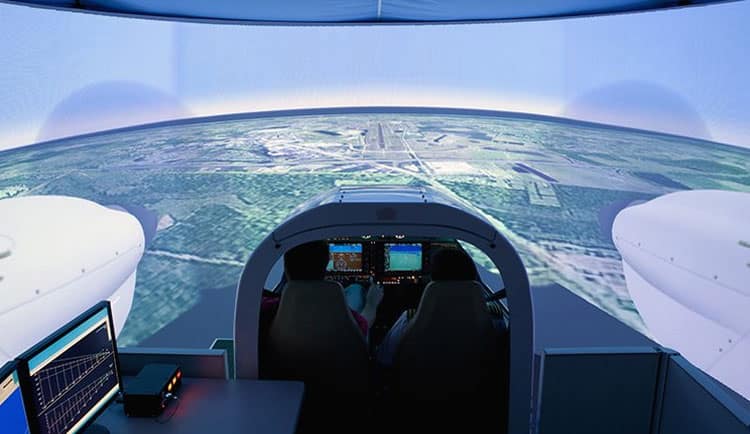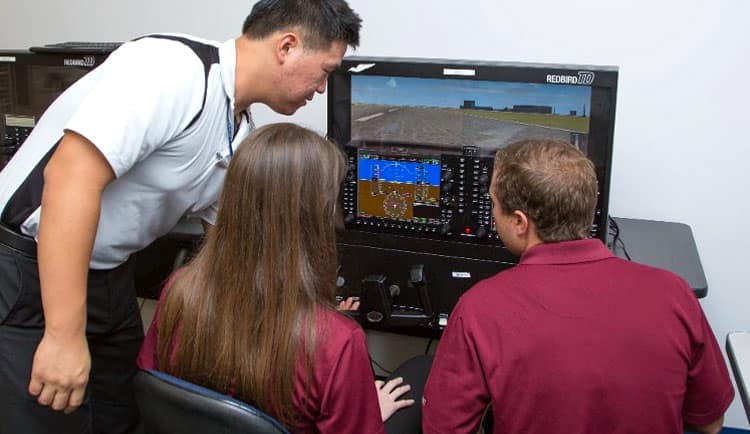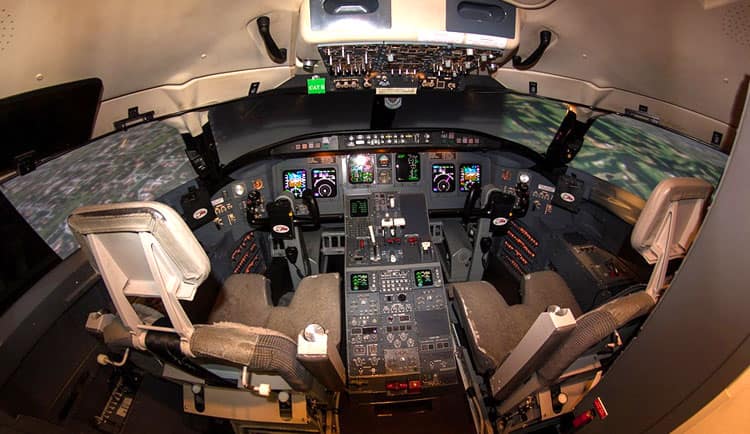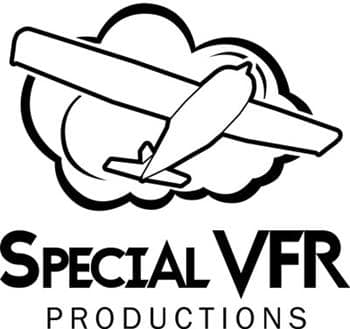The Federal Aviation Administration (FAA) has given its top-level approval to Embry-Riddle's Flight Simulation and Training Devices.
Flight Simulation and Training Devices (FSTDs) include both Full Flight Simulators (FFSs) as well as Flight Training Devices (FTDs). Unlike Full-Flight Simulators, FTDs do not require a motion platform or a visual system.
The University’s fleet of FTDs is FAA-qualified to L6, yet, unlike other FAA-qualified FTDs, our single and multiengine devices include 220-degree panoramic visual theaters that enhance the sensation of actual flight. Our Regional Jet FTD includes a 180-degree Collimated visual system.
No other collegiate flight training program offers a multimillion-dollar distributed simulation network composed of 11 state-of-the-art Frasca FTDs. Our Advanced Flight Simulation Center houses the following Level 6 FTDs:
- Eight Cessna 172S (Skyhawk)
- Two Diamond DA42-VI
- One Canadair Regional Jet (CRJ-200)
In addition, our Aviation Building houses Air Traffic Control and Tower simulators, one motion-based disorientation trainer, and six Basic-Aviation Training Devices (B-ATDs).
Flight simulation enables students to learn aircraft performance, experience aerodynamic effects, and perform flight maneuvers immediately and without risk.
Qualified to L6, our devices faithfully reproduce Embry-Riddle’s fleet of single and multiengine aircraft. In addition, our general aviation (GA) fleet is equipped with 220-degree panoramic visual theaters. These theaters display a satellite-based terrain augmented by an extensive airport database. Our airports include navigation aids, runways, taxiways, towers, hangars, and even lighting systems.
Our CRJ-200 FTD includes Collimation technology, which introduces a three-dimensional effect to the visual theater. Flight instructors can adjust different factors that affect flying, such as hazardous weather conditions and crowded airspace.
As a simulation network, our operators can participate in group or mission training. In fleet mode, instructors and students are able to communicate across devices and observe each other on the panoramic displays. In an academic setting, our Central Console allows all devices to be controlled by a single instructor or faculty member, while our Debriefing Stations allow the reproduction of training sessions, adding to student feedback and review.
Flight simulation in our FTDs enables students to learn more about aircraft performance and aerodynamics earlier in their training and to perfect difficult flight maneuvers without risk.
In simulation training, the instructor has the ability to control environmental conditions and traffic loads. Furthermore, they can freeze and reposition each device instantly. These features allow 100 percent time-on-task, which is not possible in actual flight.
Aircraft availability is limited by periodic mandatory maintenance periods not required for simulation devices. Though our fleet is expertly tested daily prior to release for service, FTDs can easily maintain an availability in excess of 95 percent.
Our experienced engineering and support staff, quality assurance and control methods, and yearly FAA evaluations ensure perfect training all the time, every time.
The procurement cost of simulation and training devices is quickly offset by low maintenance requirements and high utilization. Operating under FAA Part 141, the flexible and conforming nature of our curriculum, combined with the high training credit allowed by the Level 6 qualification, allow us to offer high-quality, affordable training.
In addition, the cost of upgrading visual systems and avionics is not passed on to our students. This allows us to continuously improve our training fleet while maintaining a high degree of service and satisfaction.
The combined number of FTDs at both our Daytona Beach and Prescott campuses makes Embry-Riddle the single largest collegiate flight training operator of Level 6 FTDs in the world.
Our Flight Training Devices and Full Flight Simulators
Frasca C172
This Flight Training Device simulates a Cessna 172 (single-engine) aircraft and is the first FTD that student pilots use at ERAU.
More about the Frasca C172Frasca CRJ-200
This Flight Training Device is used to introduce upper-level students to the specialized skills and environment they will encounter in commercial aviation.
GAT-II Spatial Disorientation Trainer
This Flight Training Device is a multifunctional flight trainer that emulates the performance of a generic aircraft in a realistic flight environment.
Frasca DA42-VI
This Flight Training Device simulates a Diamond DA42-VI (multiengine) aircraft and features a panoramic 220-degree visual display system.
Redbird Xwind SE
This Flight Training Device enables ERAU flight students to safely practice approach and landing procedures for dealing with both steady crosswinds and strong wind gusts.
More about the Redbird Xwind SEFAA Level-D CRJ-200
This Full Flight Simulator is the perfect environment for sharpening skills with CRM, electronic flight management systems, advanced aeronautical decision-making, and more.
Advanced Flight Simulation Center
The state-of-the-art Sim Center represents Embry-Riddle’s commitment to using simulation as an integral component of our flight training curriculum.
Learn more about the Sim Center
College of Aviation Aviation Learning Center
The COA Aviation Learning Center has a variety of training aids and resources available to students free of charge and can be used with or without an instructor.

